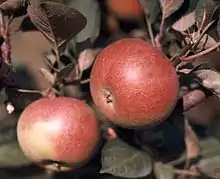Dabinett
'Dabinett' is an apple cultivar, customarily used in Somerset for making cider.
| Malus domestica 'Dabinett' | |
|---|---|
 | |
| Cultivar | 'Dabinett' |
| Origin | England, probably early 1900s |
History
'Dabinett' probably dates from the early 1900s, when it was found by William Dabinett growing as a wilding (a natural seedling) in a hedge at Middle Lambrook, South Petherton, Somerset.[1] The exact genetic makeup of Dabinett is unknown, though one 'parent' was probably the Chisel Jersey apple, a similar late "bittersweet" variety. The variety became very popular and was widely planted across the south-west of England.
A seedling of this variety, known as 'Black Dabinett', also locally known as 'Tommy Rodford', arose at Kingsbury Episcopi near Martock.[2] It is similar to 'Dabinett' proper but is purplish in colour and generally more vigorous.
Characteristics
Classed as a "bittersweet" cider apple, 'Dabinett' has small, yellow-green fruit flecked with red, usually harvested in November in the United Kingdom. The flesh is greenish and aromatic. The tree has a relatively small and spreading habit; it has a high resistance to apple scab and canker. Acid content 0.18%
The fruit is of sufficient quality to make a single varietal cider, and a number of commercial cider manufacturers produce ciders made solely or primarily with 'Dabinett' apples, including Marshwood Vale Cider, The Tricky Cider Co, Thatchers and Sheppy's.
References
- Morgan, Richards and Dowle, The New Book of Apples, Ebury, 2002, p.282
- Morgan, Richards and Dowle, p.281
- "Cider apple variety: Dabinett". New South Wales Department of Primary Industries. Archived from the original on 2015-11-17. Retrieved 2015-11-15.
- "Dabinett", National Fruit Collection, University of Reading and Brogdale Collections, retrieved 18 October 2015
